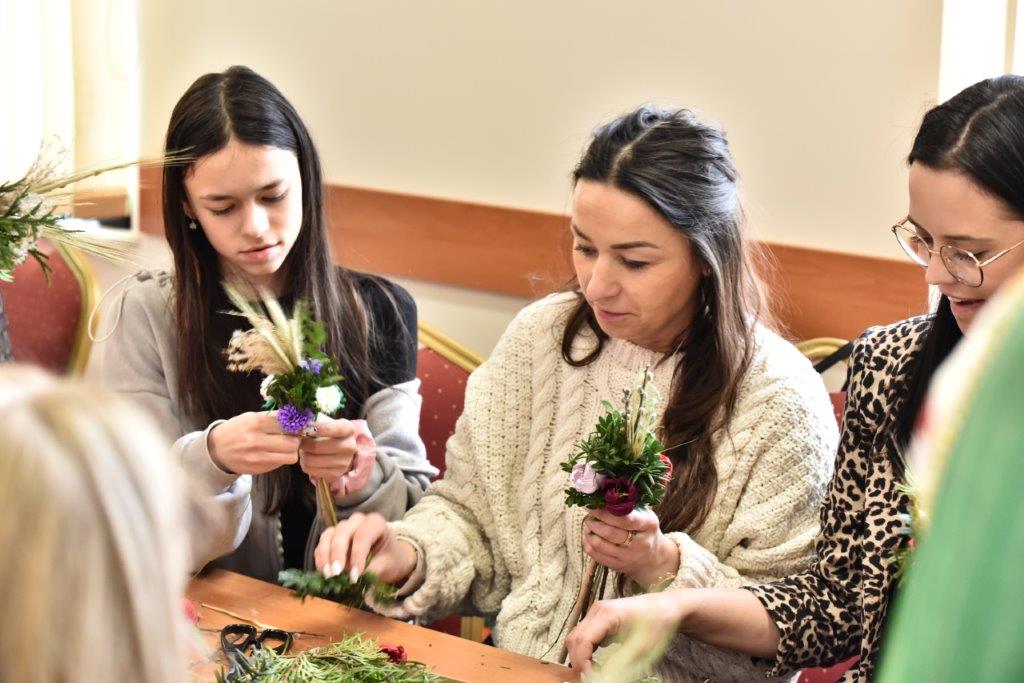W sobotę 15 lutego 2025 r. Narodowy Instytut Kultury i Dziedzictwa Wsi wraz z Gminnym Centrum Kultury i Czytelnictwa w Zabrodziu zaprosił na spotkanie warsztatowe wspomagające koła gospodyń wiejskich w działaniach twórczych z Gminy: Brańszczyk, Długosiodło, Rząśnik, Somianka i Zabrodzie oraz miejsko- wiejskiej gminy Wyszków.
At the beginning of the meeting there was a lecture prepared by Ms. Sylwia Słojkowska- Affelska, ethnographer. The lecture was devoted to the ways of using tangible and intangible cultural heritage. Ms. ethnographer discussed the importance of traditional crafts such as cut-outs, embroidery and braiding, as well as rituals, songs and culinary arts in building local identity and promoting the region. She emphasized how KGWs can combine tradition and modernity by organizing workshops, events and educational activities. The meeting was an inspiration to further develop and popularize Kurpie heritage in everyday life and social activities.
The stage also featured a performance by the Band "Slava" from the KGW of Zabrodzia, which was full of energy, colors and traditional spirit. Folk songs sounded, accompanied by an accordion. The colorful costumes and authentic performance of regional songs delighted the audience, creating an unforgettable atmosphere and evoking the spirit of old traditions.
During the workshop, Ms. Beata Pasinska from Brok showed participants how to create flowers from tissue paper and crepe paper, which have been a decorative element in Kurpie folk culture for years. Participants learned how to form a variety of flowers, which were used in further parts of the workshop.
Under the watchful eye of Mrs. Monika Poteraj of Przyłub, traditional Easter palms were created. Thanks to the use of natural materials, such as basil, boxwood, blueberry or ears of grain and grass, beautiful traditional palms were created, which will certainly decorate the Easter holidays.
Participants could also try their hand at folk cut-outs under the guidance of Ms. Czeslawa Kaczynska of Dylewo. Unusual handmade paper compositions inspired by traditional regional motifs of Kurpi Białe and Zielona were created.
Ms. Halina Witkowska from Leman led a workshop on oklejanka - a type of Easter egg decorated with rush core and colorful threads, characteristic of the White Forest region.
The braiding classes, conducted by Mr. Wieslaw Kuskowski from Ostroleka, also proved to be extremely interesting. Participants learned basic techniques for weaving baskets and ornaments from wicker and other natural materials. The handicraft, although requiring precision, gave everyone a lot of satisfaction.
There were also culinary workshops. Mr. Stanislaw Ropiak of Myszyniec Stare introduced everyone to the secrets of baking ceremonial dough, which has accompanied important ceremonies and holidays for centuries. Byśki and new latko became one of the biggest attractions of the meeting.
During the workshop, the sounds of harmony filled the space, creating a unique atmosphere for the meeting. The music played by Mr. Jerzy Swiech referred to traditional folk melodies characteristic of the Biala and Zielona Primeval Forest region, including lively obereks, polkas and mazurkas. The lively, rhythmic sound encouraged singing and dancing together, emphasizing the joyful, inclusive atmosphere of the meeting.
The entire event took place in a relaxed and creative atmosphere, full of commitment and enjoyment of working together. Participants not only gained new skills, but also had the opportunity to integrate and rediscover the beauty of traditional handicrafts. We hope that the knowledge and inspiration gained will result in more wonderful works. Thank you all for your participation!
Video and photos: Monika Brzozowska

